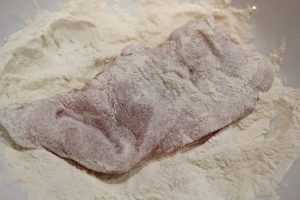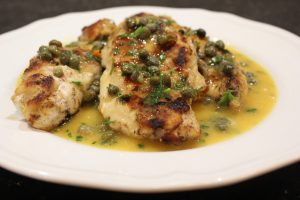Early December, our Premier announced our hard border, separating us from the rest of Australia would come down on 5th February. Then Omicron arrived in the east and spread quickly. The border will not open and due to some spread in WA and associated risk we are staying close to home.
cooking


chicken piccata
Chicken in Lemon Butter Caper Sauce
Every time I saw the bottle of capers in the fridge I thought about making CHICKEN PICCATA. One of the ingredients in the sauce is lemons and they are near the end of their season with only a few late ones on the tree so time was running out to make this traditional Italian chicken dish.
Gather (for 4 serves) two free range chicken breasts. (These can vary in size so I used two large, similar sized ones.) Cut them in half longways and pound to an even thickness. (I use a rolling pin but you can use a proper meat mallet or even a bottle.)
Dredge the fillets in the flour making sure all the flesh is covered. Traditionally, the breasts would be dipped in oil or sprayed with oil before going in the flour but I skip that step.


Heat a good slosh of oil in a heavy based pan. Brown the breasts. Each side takes about 5 minutes on a medium heat.


Set aside and wipe any burnt bits out of the pan using a paper towel. For the sauce, gather 2 tbspn lemon lemon juice, 30gm butter, 2/3 cup white wine (I used a good chicken stock pod instead and added water to equal 2/3 cup), 3 tbspn drained capers and 3 tbspn chopped parsley.


Simmer the wine/stock over medium heat in the pan used for the chicken for about 3 minutes before adding the lemon and chopped butter. Let it just melt and slightly thicken before adding the capers and the parsley.
Place the chicken breasts back in the pan in the sauce to warm, serve with beans and mashed potato or anything else you fancy!

reading


Staying cool and having time has resulted in me reading many books in the past ten days and I really, really enjoyed it! Kate Longbroek’s Ciao, Bella (here) prompted me to borrow Frances Mayes’s Always In Italy. This wonderful, comprehensive travelogue zigzags through Italy, explaining the characteristics of each region, the best sites to visit, recommending hotels and restaurants and wines particular to each area. Vicarious travel at its best.
Then two books about using less. The first is a history of consumption, outlining how everything had value and was recycled from clothing, to furniture, cookware to building materials and so much more. Screws, springs, nails, everything had value in the second hand market. Robyn Annear’s Nothing New A History of Second Hand is full of interesting little anecdotes and facts. Where once, owning ‘used’ things was normal, she outlines our evolution to constantly buying new things and makes it clear this cannot continue.
The second book is about reducing our use of plastics. Kate Nelson’s ideas and tips about using less plastic, shopping and eating and generally living plastic free are all easy to incorporate into your life. I Quit Plastics and So Can You is based on statistics concerning the amount of plastic waste in the world and its impact on the environment. The figures are very disturbing. This is a great source for making change if you are worried by unthinking consumerism.
Then another travel book Night Train to Varanasi, written by Australian Sean Doyle, about taking his daughter to India when she finished school. India had charmed Doyle as a teenager and he writes eloquently about the history, landscape, religions, the heat and intensity of the crowds but mostly about his continuing passion for the country.
During the journey he begins to understand his daughter’s anorexia and the impact of his decisions on her and how she is gaining confidence and strength from being in his company. Fascinating in parts but this felt like two books; one about the history of India and one about showing his daughter India. I found myself flicking through some of the dense historical and religious information but I enjoyed Doyle’s insights into his family and his aspirations for his own girls.


Liz Byrski’s At The End Of The Day was another great read from this well known local author. She writes about women her own age (in their 70s) and their aspirations, limitations, families and friends. This book particularly resonated as there’s not many books written about the suburbs between Perth and Fremantle. I particularly found the impact of childhood polio on one of the characters in her 70s very interesting.
Salley Vicker’s The Gardener was a great book and I’ve already recommended it to some friends. Two sisters use an inheritance from their father to buy a house in the country. One continues working in the City and the other, a book illustrator, moves into the house and begins renovating the garden. She establishes herself in the village and becomes friendly with some of the locals and restores the garden. A lovely book.
The final book I in my pile is Beneath The Fig Leaves by Olympia Panagiotopoulos. This lovely memoir tells the story of Panagiotopoulos’s family coming to Australia from Greece in 1955 and how they adapted to life here and still maintained many of their traditions.
This book is based on reminiscences with her 91 year old mother, descriptions of the garden and its bounty and lots of recipes plus family rituals. Warm and inspiring I really enjoyed reading about the history, family traditions and food in this memoir but began skipping bits because the story became a bit repetitive.
February 4th is WORLD CANCER DAY. Support research, if you can, by donating or sponsoring fund raising activities.
